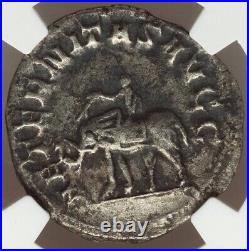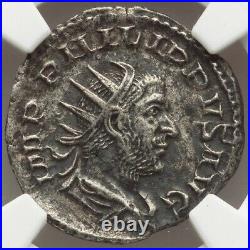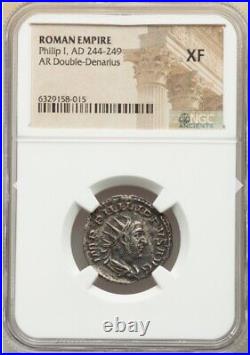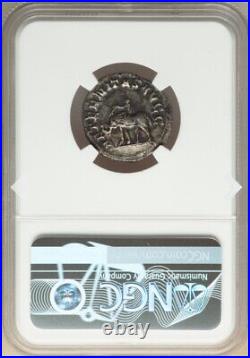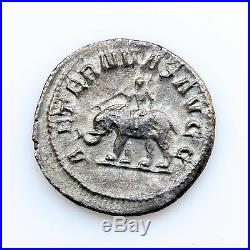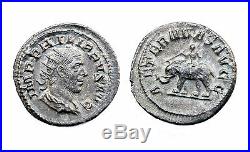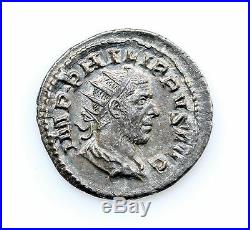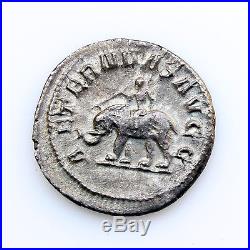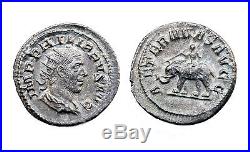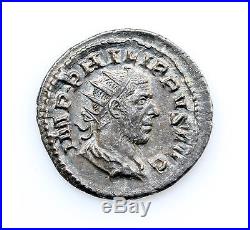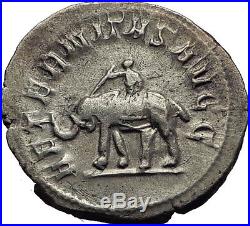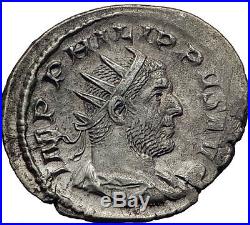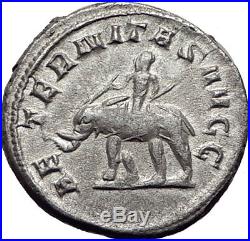
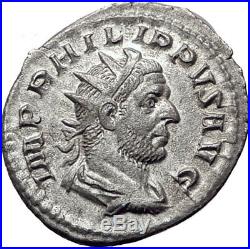

Item: i65200 Authentic Ancient Coin of. Philip I’the Arab. Silver Antoninianus 22mm (4.14 grams) Rome mint: 248 A. Commemorating the 1000th Anniversary. Of the founding of Rome Reference: RIC 58, RSC 17 IMP PHILIPVS AVG, radiate, draped and cuirassed bust right, seen from behind. AETERNITAS AVG G, Elephant advancing left, guided by mahout holding goad and wand. The most noteworthy event of Philip I’s reign was the delayed celebration in 248 AD of the thousandth anniversary of the foundation of Rome. Lavish games and other spectacles were staged for the amusement of the Roman people and were commemorated by an extensive issue of coins. Animals had originally been collected from all over the Roman Empire for the planned Persian triumph of Philip’s predecessor, Gordian III, but following his assassination in 244 they were instead kept in readiness for the festivities of the millennium. Continuing the tradition of Claudius and Antoninus Pius before him, the celebration of the Secular Games at the end of every century since the founding of Rome culminated during the reign of Philip I, as the city celebrated her 1000th anniversary in AD 248. Types include the she-wolf suckling the twins Remus and Romulus, the various wild beasts paraded through the Flavian amphitheater, better known as the Colosseum, and a cippus inscribed for the preservation of the memory of these events. The Colosseum or Coliseum , also known as the Flavian Amphitheatre or Colosseo , is an oval amphitheatre in the centre of the city of Rome, Italy. Built of concrete and sand, it is the largest amphitheatre ever built and is considered one of the greatest works of architecture and engineering ever. The Colosseum is situated just east of the Roman Forum. Construction began under the emperor Vespasian in 72, and was completed in 80 under his successor and heir Titus. Further modifications were made during the reign of Domitian (81-96). These three emperors are known as the Flavian dynasty, and the amphitheatre was named in Latin for its association with their family name (Flavius). The Colosseum could hold, it is estimated, between 50,000 and 80,000 spectators, having an average audience of some 65,000; it was used for gladiatorial contests and public spectacles such as mock sea battles, animal hunts, executions, re-enactments of famous battles, and dramas based on Classical mythology. The building ceased to be used for entertainment in the early medieval era. It was later reused for such purposes as housing, workshops, quarters for a religious order, a fortress, a quarry, and a Christian shrine. Although partially ruined because of damage caused by earthquakes and stone-robbers, the Colosseum is still an iconic symbol of Imperial Rome. It is one of Rome’s most popular tourist attractions and has also links to the Roman Catholic Church, as each Good Friday the Pope leads a torchlit “Way of the Cross” procession that starts in the area around the Colosseum. The Colosseum is also depicted on the Italian version of the five-cent euro coin. The Colosseum’s original Latin name was Amphitheatrum Flavium , often anglicized as Flavian Amphitheater. The building was constructed by emperors of the Flavian dynasty, following the reign of Nero. This name is still used in modern English, but generally the structure is better known as the Colosseum. In antiquity, Romans may have referred to the Colosseum by the unofficial name Amphitheatrum Caesareum (with Caesareum an adjective pertaining to the title Caesar), but this name may have been strictly poetic as it was not exclusive to the Colosseum; Vespasian and Titus, builders of the Colosseum, also constructed an amphitheater of the same name in Puteoli (modern Pozzuoli). The name Colosseum has long been believed to be derived from a colossal statue of Nero nearby (the statue of Nero was named after the Colossus of Rhodes). This statue was later remodeled by Nero’s successors into the likeness of Helios (Sol) or Apollo, the sun god, by adding the appropriate solar crown. Nero’s head was also replaced several times with the heads of succeeding emperors. Despite its pagan links, the statue remained standing well into the medieval era and was credited with magical powers. It came to be seen as an iconic symbol of the permanence of Rome. In the 8th century, a famous epigram attributed to the Venerable Bede celebrated the symbolic significance of the statue in a prophecy that is variously quoted: Quamdiu stat Colisæus, stat et Roma; quando cadet colisæus, cadet et Roma; quando cadet Roma, cadet et mundus (“as long as the Colossus stands, so shall Rome; when the Colossus falls, Rome shall fall; when Rome falls, so falls the world”). This is often mistranslated to refer to the Colosseum rather than the Colossus (as in, for instance, Byron’s poem Childe Harold’s Pilgrimage). However, at the time that the Pseudo-Bede wrote, the masculine noun coliseus was applied to the statue rather than to what was still known as the Flavian amphitheatre. The Colossus did eventually fall, possibly being pulled down to reuse its bronze. By the year 1000 the name “Colosseum” had been coined to refer to the amphitheatre. The statue itself was largely forgotten and only its base survives, situated between the Colosseum and the nearby Temple of Venus and Roma. The name further evolved to Coliseum during the Middle Ages. In Italy, the amphitheatre is still known as il Colosseo , and other Romance languages have come to use similar forms such as Coloseumul (Romanian), le Colisée (French), el Coliseo (Spanish) and o Coliseu (Portuguese). A mahout is a person who rides an elephant. The word mahout comes from the Hindi words mahaut and mahavat , which eventually goes back to Sanskrit mahamatra. Usually, a mahout starts as a boy in the’family profession’ when he is assigned an elephant early in its life. They remain bonded to each other throughout their lives. Marcus Julius Philippus or Philippus I Arabs c. 204-249, known in English as Philip the Arab or formerly (prior to World War II) in English as Philip the Arabian , was a Roman Emperor from 244 to 249. Little is known about Philip’s early life and political career. He was born in Shahba, about 55 miles southeast of Damascus, in the Roman province of Syria. Philip has the nickname “the Arab” because he had family who had originated in the Arabian peninsula, believed to be distant descendants of the prestigious Baleed family of Aleppo. Philip was the son of a Julius Marinus, a local Roman citizen, possibly of some importance. Many historians agree that he was of Arab descent who gained Roman citizenship through his father, a man of considerable influence. Many citizens from the provinces took Roman names upon acquiring citizenship. This makes tracing his Arabic blood line difficult. However, it is documented that Rome used the Ghassan tribe from the Azd of Yemen as vassals to keep the neighboring northern Arabs in check. The name of Philip’s mother is unknown, but sources refer to a brother, Gaius Julius Priscus, a member of the Praetorian guard under Gordian III (238-244). In 234, Philip married Marcia Otacilia Severa, daughter of a Roman Governor. They had two children: a son named Marcus Julius Philippus Severus (Philippus II) in 238 and according to numismatic evidence they had a daughter called Julia Severa or Severina, whom the ancient Roman sources don’t mention. Philip became a member of the Pretorian Guard during the reign of the emperor Alexander Severus, who was a Syrian. In ancient Rome the Pretorian Guard was closely associated with the emperor, serving among other things as the emperor’s bodyguard. In 243, during Gordian III’s campaign against Shapur I of Persia, the Praetorian prefect Timesitheus died under unclear circumstances. At the suggestion of his brother Priscus, Philip became the new Praetorian prefect, with the intention that the two brothers would control the young Emperor and rule the Roman world as unofficial regents. Following a military defeat, Gordian III died in 244 under circumstances that are still debated. While some claim that Philip conspired in his murder, other accounts (including one coming from the Persian point of view) state that Gordian died in battle. Whatever the case, Philip assumed the purple following Gordian’s death. According to Edward Gibbon. His rise from so obscure a station to the first dignities of the empire seems to prove that he was a bold and able leader. But his boldness prompted him to aspire to the throne, and his abilities were employed to supplant, not to serve, his indulgent master. Philip was not willing to repeat the mistakes of previous claimants, and was aware that he had to return to Rome in order to secure his position with the senate. He thus travelled west, after concluding a peace treaty with Shapur I, and left his brother Priscus as extraordinary ruler of the Eastern provinces. In Rome he was confirmed Augustus , and nominated his young son Caesar and heir. Philip’s rule started with yet another Germanic incursion on the provinces of Pannonia and the Goths invaded Moesia (modern-day Serbia and Bulgaria) in the Danube frontier. They were finally defeated in the year 248, but the legions were not satisfied with the result, probably due to a low share of the plunder, if any. Rebellion soon arose and Tiberius Claudius Pacatianus was proclaimed emperor by the troops. The uprising was crushed and Philip nominated Gaius Messius Quintus Decius as governor of the province. Future events would prove this to be a mistake. Pacatianus’ revolt was not the only threat to his rule: in the East, Marcus Jotapianus led another uprising in response to the oppressive rule of Priscus and the excessive taxation of the Eastern provinces. Two other usurpers, Marcus Silbannacus and Sponsianus, are reported to have started rebellions without much success. 248 April 1000 A. , Philip had the honour of leading the celebrations of the one thousandth birthday of Rome, which according to tradition was founded in 753 BC by Romulus. He combined the anniversary with the celebration of Rome’s alleged tenth saeculum. According to contemporary accounts, the festivities were magnificent and included spectacular games, ludi saeculares, and theatrical presentations throughout the city. In the coliseum, more than 1,000 gladiators were killed along with hundreds of exotic animals including hippos, leopards, lions, giraffes, and one rhinoceros. The events were also celebrated in literature, with several publications, including Asinius Quadratus’s History of a Thousand Years , specially prepared for the anniversary. Despite the festive atmosphere, discontent in the legions was growing. Decius (249-251) was proclaimed Emperor by the Danubian armies in the spring of 249 and immediately marched to Rome. Philip’s army met the usurper near modern Verona that summer. Decius won the battle and Philip was killed sometime in September 249, either in the fighting or assassinated by his own soldiers who were eager to please the new ruler. Philip’s eleven-year-old son and heir may have been killed with his father and Priscus disappeared without a trace. Further information: Philip the Arab and Christianity. Some later traditions, first mentioned in the historian Eusebius in his Ecclesiastical History , held that Philip was the first Christian Roman emperor. This tradition seems to be based on reports in Eusebius that Philip allegedly had once entered a Christian service on Easter, after having been required by a bishop to confess his sins. Later versions located this event in Antioch. However, historians generally identify the later Emperor Constantine, baptised on his deathbed, as the first Christian emperor, and generally describe Philip’s adherence to Christianity as dubious, because non-Christian writers do not mention the fact, and because throughout his reign, Philip to all appearances coinage, etc. Continued to follow the state religion. Critics ascribe Eusebius’ claim as probably due to the tolerance Philip showed towards Christians. Saint Quirinus of Rome was, according to a legendary account, the son of Philip the Arab. World-renowned expert numismatist, enthusiast, author and dealer in authentic ancient Greek, ancient Roman, ancient Byzantine, world coins & more. Ilya Zlobin is an independent individual who has a passion for coin collecting, research and understanding the importance of the historical context and significance all coins and objects represent. Send me a message about this and I can update your invoice should you want this method. Getting your order to you, quickly and securely is a top priority and is taken seriously here. Great care is taken in packaging and mailing every item securely and quickly. What is a certificate of authenticity and what guarantees do you give that the item is authentic? You will be very happy with what you get with the COA; a professional presentation of the coin, with all of the relevant information and a picture of the coin you saw in the listing. Additionally, the coin is inside it’s own protective coin flip (holder), with a 2×2 inch description of the coin matching the individual number on the COA. Whether your goal is to collect or give the item as a gift, coins presented like this could be more prized and valued higher than items that were not given such care and attention to. When should I leave feedback? Please don’t leave any negative feedbacks, as it happens sometimes that people rush to leave feedback before letting sufficient time for their order to arrive. The matter of fact is that any issues can be resolved, as reputation is most important to me. My goal is to provide superior products and quality of service. How and where do I learn more about collecting ancient coins? Visit the “Guide on How to Use My Store”. For on an overview about using my store, with additional information and links to all other parts of my store which may include educational information on topics you are looking for. The item “PHILIP I the ARAB 1000 Years of Rome ELEPHANT COLOSSEUM Silver Roman Coin i65200″ is in sale since Saturday, November 04, 2017. This item is in the category “Coins & Paper Money\Coins\ Ancient\Roman\ Imperial (27 BC-476 AD)”. The seller is “highrating_lowprice” and is located in Rego Park, New York. This item can be shipped worldwide.
- Ruler: Philip I
- Composition: Silver
- Material: Silver
- Ancient Coins: Roman Coins

